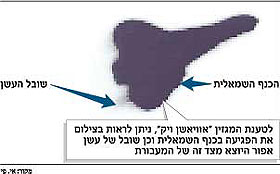Additional lines of investigation: the damage to the wing was caused by ice and not insulation foam, the autopilot failed or the shuttle was hit by space debris
 Photographs of the shuttle a minute before the crash Photo: NASA
Photographs of the shuttle a minute before the crash Photo: NASA
In the US, the investigation into the Columbia ferry crash continues, and around 1,200 people are searching for the fragments scattered over a wide area. At the same time, other theories about the circumstances of the crash are coming into focus, which are supported by new findings that are being published.
This happened over the weekend, when the weekly "Aviation Week" reported about photographs of the shuttle captured by a long-range camera lens of the American Air Force, about a minute before it disintegrated. According to the report, significant damage to the left wing can be seen in the photographs. The media rushed to analyze the photographs even before they were published, and the experts concluded that the damage to the wing was aggravated upon entry into the atmosphere and caused a tear or loss of control over the planned entry angle, and at the end of the process - the shuttle disintegrated.
According to the report in the weekly, it is a sophisticated camera that provides very sharp photographs, but when the photographs were published, disappointment was evident. They showed a blurry silhouette of the shuttle, and only hinted at the possibility that something had indeed gone wrong with the left wing: damage to the front of the wing was barely discernible, and a strange trail could be seen on its trailing edge.
NASA said in response that the photographs are being examined by experts, but they do not shed new light on the investigation. The director of NASA's shuttle program, Ron Ditmore said: "We cannot draw any definite conclusions from these images at this time."
NASA constantly emphasizes that all directions of investigation are open and that all theories are being tested, including the theory about damage to the wing caused by an impact of insulation foam during the launch - a belief that NASA has announced that it denies. At the end of the week, the NBC network published reports from the Boeing company, which manufactures the shuttle, according to which NASA's estimates after the launch were wrong. NASA estimated after the launch that the damage to the wing was not significant, but now it is known that these estimates were based on unproven conclusions, and therefore there was a degree of complacency in them. The reports focus on the possibility that what hit the wing at launch was ice and not insulation foam, which is relatively light, and therefore NASA's estimates of possible damage should have been quite different.
The network also published expert assessments according to which the angle set by the autopilot computer for the shuttle's entry into the atmosphere was incorrect, causing a loss of control or overheating and a crash. This estimate is based on the latest flight data received in Houston.
Part of a wing was found
Additional flight data was also located - data that was not in NASA's hands until now. The agency's investigators hoped that additional tracking stations collecting data were able to record the flight data sent by the shuttle after Houston lost contact with it. However, out of the 32 missing seconds, only one second of information has been received so far. However, NASA says that every piece of information is important and can lead to clues about the circumstances of the crash.
We also learned about finding parts of the shuttle wing near Fort Worth, Texas. Among other things, there is also a remnant of the front part which is the focus of attention. However, at the moment it is not yet clear which wing it is - right or left.
At the same time, another theory emerges based on information according to which some part of the shuttle disconnected about 24 hours after the launch. Experts estimate that something may have hit the passages and caused damage to the wing or other damage that could not be assessed. The experts say that it may be a space-debris impact - parts and remnants of spacecraft left floating in the atmosphere or just planned trash dumping by the crew.
